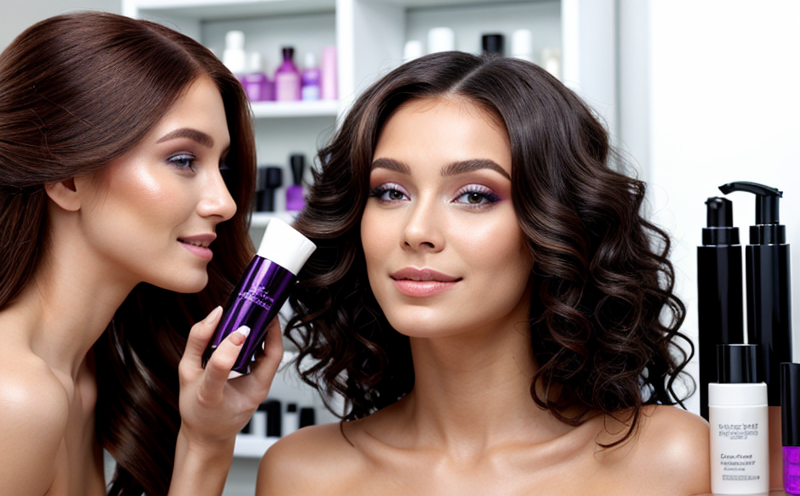Anti-Frizz Efficacy Testing of Hair Serums
The anti-frizz efficacy testing of hair serums is a critical process in cosmetic product development. This service ensures that the formulated ingredients effectively reduce frizz and enhance the overall manageability of hair, providing consumers with a positive user experience. Frizz can be caused by various factors such as humidity, environmental conditions, and poor styling practices. Therefore, it is essential for manufacturers to rigorously test their serums in controlled environments that mimic real-world conditions.
The testing process involves several steps, including the selection of appropriate hair types and lengths, preparation of the serum samples, and application techniques. These parameters are carefully chosen based on industry standards such as ISO 2159:2017 and ASTM D7646-18 to ensure consistency and comparability across different products.
During testing, various physical properties like tensile strength, elasticity, and curl retention are measured. These metrics provide insights into how well the serum performs under stress conditions, which is crucial for understanding its long-term effectiveness. Additionally, visual assessments by trained evaluators assess the appearance of treated hair before and after treatment.
Environmental factors such as temperature and humidity play a significant role in determining frizz levels; hence, controlled chambers are used to simulate these variables accurately. The results obtained from these tests help manufacturers identify areas for improvement and optimize their formulations accordingly.
The importance of anti-frizz efficacy testing cannot be overstated given the growing demand for natural and organic products that offer effective solutions without compromising on safety or performance standards. By investing in thorough testing processes early on, companies can build trust with consumers who increasingly seek out reliable information about what goes into their personal care products.
In summary, anti-frizz efficacy testing serves multiple purposes – ensuring product quality, meeting regulatory requirements, satisfying customer expectations, and promoting brand reputation through consistent performance across all batches produced. It is an integral part of any cosmetic company’s quality assurance program aimed at delivering superior haircare solutions that meet market needs effectively.
Scope and Methodology
The scope of anti-frizz efficacy testing encompasses a comprehensive evaluation of various aspects related to the performance of hair serums intended for reducing frizz. This includes not only the active ingredients but also how they interact with different types of hair, including chemically treated or damaged strands.
| Parameter | Description |
|---|---|
| Initial Hair Condition Assessment | A baseline measurement of the natural state of test subjects' hair before applying any product. |
| Application Procedure | Instructions for correctly applying the serum to ensure accurate results during testing. |
| Control Group Comparison | The application and comparison with a placebo or competitor product to establish effectiveness. |
| Post-Treatment Evaluation | An analysis of the hair's appearance and texture post-treatment, focusing on frizz reduction. |
The methodology for performing anti-frizz efficacy tests involves several key steps:
- Sample Preparation: Select representative samples from batches of the serum to be tested. These should ideally reflect typical usage conditions, including application frequency and volume.
- Treatment Application: Apply the serum according to manufacturer instructions or standard protocols where available.
- Control vs Test Group: Compare treated versus untreated samples using visual inspection and quantitative analysis tools.
- Data Collection & Analysis: Gather data on various parameters such as humidity levels, temperature changes, elasticity tests, and consumer feedback surveys to assess overall effectiveness.
This structured approach ensures reliable results that can be used by manufacturers to improve their formulations continuously. Regular updates to testing methodologies also help keep pace with evolving scientific knowledge in the field of cosmetology.
International Acceptance and Recognition
The anti-frizz efficacy testing process has gained widespread acceptance globally due to its relevance to consumer preferences for hair care products. Regulatory bodies worldwide recognize the importance of such tests, ensuring that they align with international standards like ISO 846:1997 (Hair and Hair Preparations – Determination of Tensile Strength) and ASTM D7646-18 (Standard Practice for Evaluating Efficacy of Hair Products).
By adhering to these guidelines, laboratories can provide credible results that are internationally recognized. This not only enhances the credibility of manufacturers but also facilitates easier market access in countries with stringent regulatory requirements.
Moreover, industry associations and organizations often recommend or require compliance with specific testing protocols when introducing new products into the marketplace. For example, the International Federation of Classification Societies (IFCS) emphasizes the need for rigorous pre-market assessments to ensure safety and efficacy.
The growing trend towards natural and sustainable practices has further increased demand for robust anti-frizz efficacy testing services. Consumers are becoming more informed about ingredient sources and processing methods used in hair care products, making it crucial for manufacturers to demonstrate transparency regarding their testing processes.
Overall, international acceptance of this service reflects the commitment of both regulators and stakeholders towards maintaining high standards in cosmetic product development while meeting evolving consumer expectations.
Environmental and Sustainability Contributions
Incorporating anti-frizz efficacy testing into a broader sustainability strategy offers numerous benefits for manufacturers and consumers alike. By focusing on reducing frizz, companies contribute positively to environmental conservation efforts by minimizing water usage during daily grooming activities.
Frizzy hair often leads people to overuse water when washing or styling their locks, which contributes significantly to global water consumption patterns. With effective serums that can manage frizz better, less water is needed for achieving desired results. Additionally, these products promote healthier lifestyles by encouraging proper hydration and nourishment of the scalp.
Moreover, anti-frizz efficacy testing plays a vital role in promoting circular economy principles within the cosmetic industry. Through continuous improvement based on test outcomes, manufacturers can reduce waste generation throughout product lifecycles while enhancing resource efficiency.
Sustainability also extends beyond just operational practices into supply chain management and marketing strategies. For instance, companies may choose suppliers who adhere to environmentally friendly manufacturing processes or adopt eco-friendly packaging materials for their products.
By prioritizing anti-frizz efficacy testing in conjunction with other sustainable initiatives, cosmetic firms can position themselves as leaders in responsible business practices, appealing both ethically conscious consumers and regulatory authorities alike.





